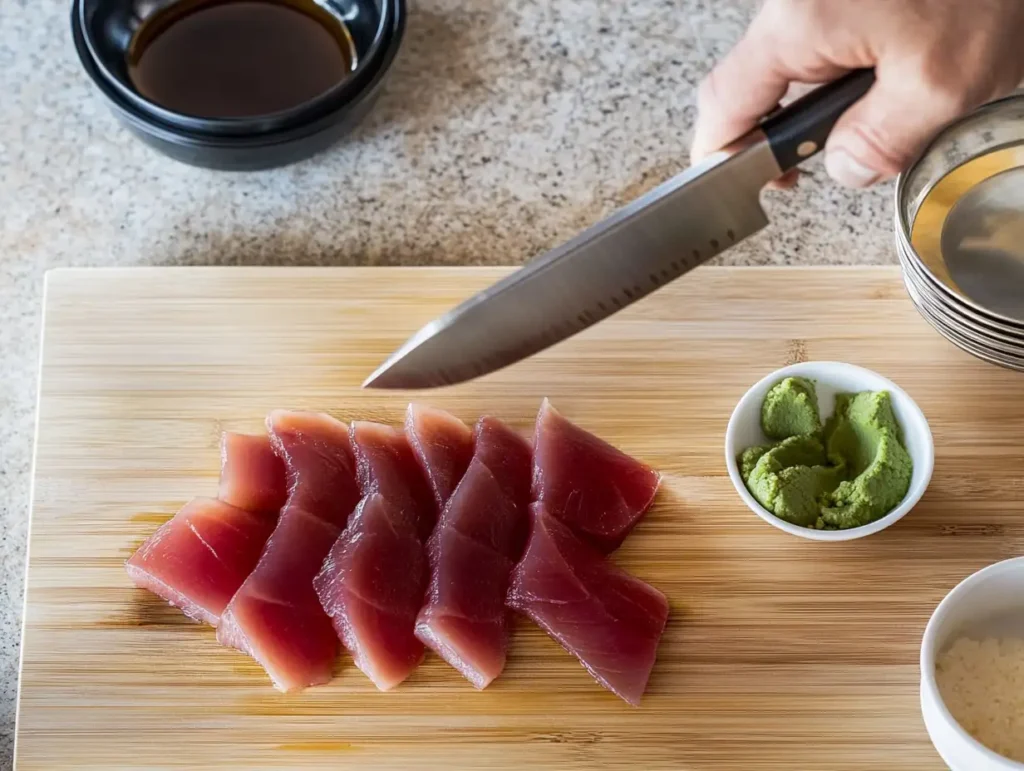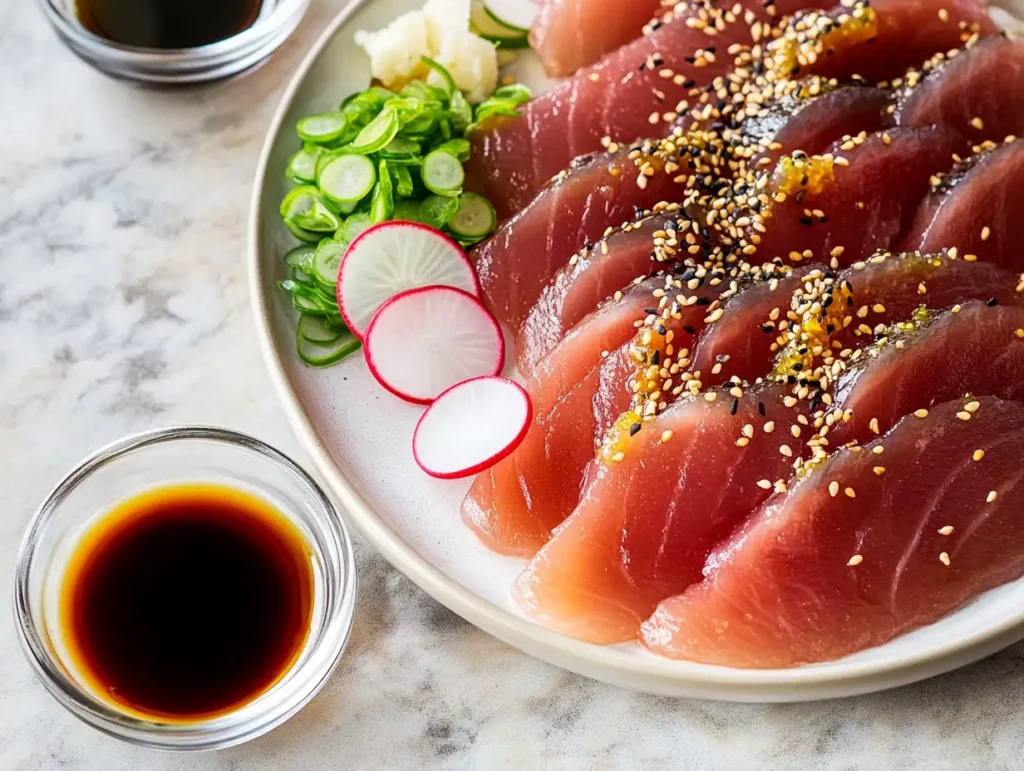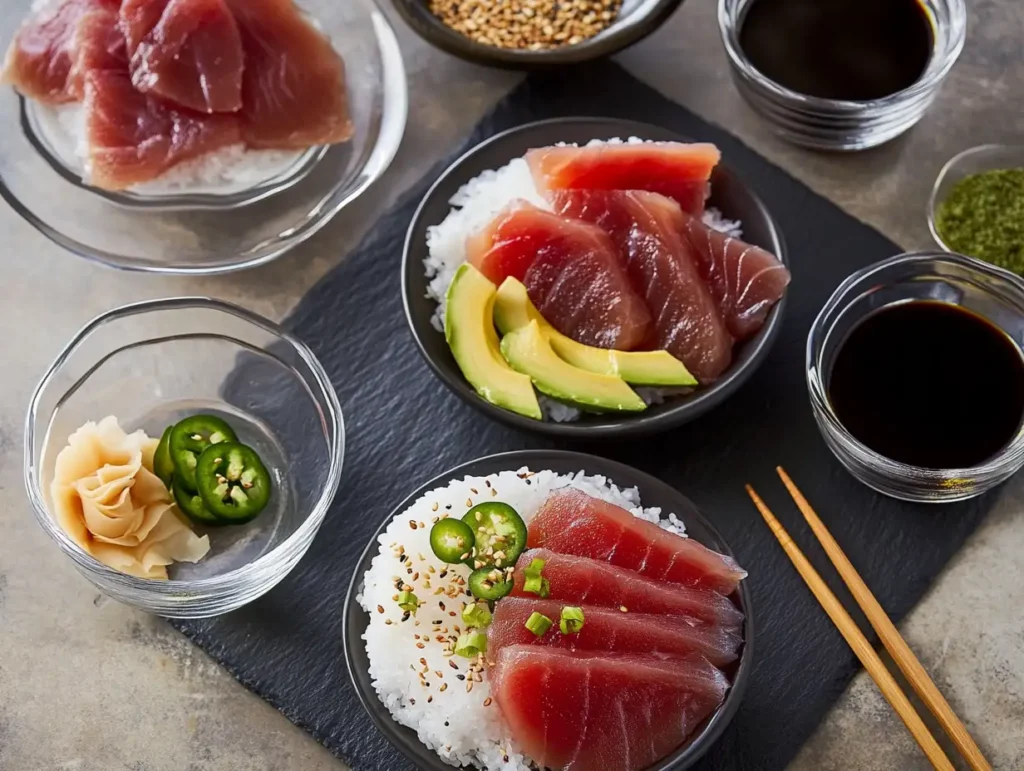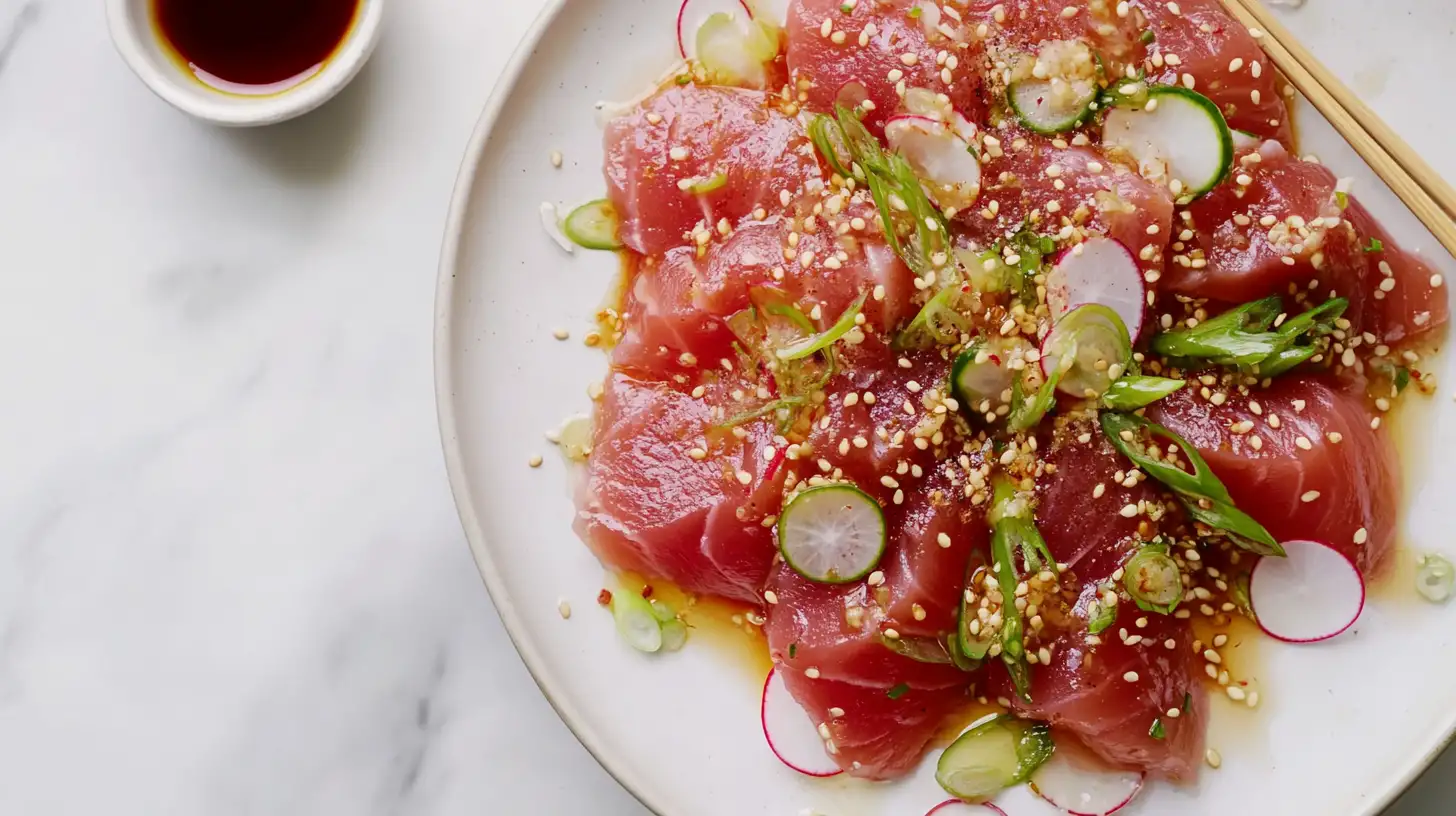Bringing Nobu’s Magic to Your Kitchen
Ohhh, tuna sashimi fresh, light, and downright addictive! There’s something magical about that silky, melt-in-your-mouth texture, especially when bathed in a bold, umami-packed marinade. Trust me, once you try this, you’ll be hooked!
If you’ve ever dined at a high-end Japanese restaurant, you know that sashimi is more than just raw fish. It’s an art form. And when it comes to world-class sashimi, few do it better than Nobu Matsuhisa, the legendary chef behind the global Nobu empire. His tuna sashimi is a masterpiece simple yet bursting with flavor, thanks to his signature citrus-soy marinade.
But here’s the best part you don’t need a Michelin-starred kitchen to make this at home! With the right ingredients and a few easy steps, you’ll be enjoying Nobu-inspired tuna sashimi in your own dining room. Whether you’re a seasoned home cook or just dipping your toes into Japanese cuisine, this recipe will impress your taste buds and your dinner guests.
Before we dive into the how-to, let’s talk about what makes sashimi special, why the quality of your tuna matters, and how to make sure you’re using the best ingredients.
What is Tuna Sashimi? A Japanese Delicacy
Sashimi is one of Japan’s most celebrated culinary traditions pure, fresh seafood sliced into delicate, bite-sized pieces. Unlike sushi, which is served with rice, sashimi is all about the fish itself.
Tuna sashimi, in particular, is a fan favorite. The rich, buttery texture of Bluefin tuna, the clean, mild flavor of Yellowfin, and the slightly firmer bite of Ahi tuna make it a perfect candidate for this dish. But tuna isn’t the only option! Salmon, yellowtail, mackerel, and even squid are popular choices for sashimi lovers.
Now, here’s where things get interesting. Sashimi is more than just raw fish it’s about balance, presentation, and a touch of umami magic. That’s where the marinade comes in. A simple mix of soy sauce, mirin, and citrus brings out the delicate sweetness of the tuna while adding depth and complexity. And let’s not forget the finishing touches thinly sliced radish, fresh scallions, and a sprinkle of sesame seeds make every bite a work of art.
Whether you’re serving it as an appetizer, a main course, or alongside other Japanese dishes, tuna sashimi is the ultimate way to enjoy fresh, high-quality seafood.
Choosing the Right Tuna: Sushi-Grade vs. Regular Tuna
Alright, let’s get real for a second not all tuna is created equal. If you’re planning to eat it raw, you need to be extra picky about where you buy it.
What Does “Sushi-Grade” Really Mean?
Here’s the tricky part there’s no official FDA regulation for “sushi-grade” fish. It’s mostly a marketing term used by seafood vendors. But don’t worry! Reputable fishmongers and specialty seafood markets follow strict handling procedures to ensure safety.
The key is flash freezing. High-quality sashimi-grade tuna is frozen at extremely low temperatures (-31°F or lower) to kill any potential parasites. This process locks in freshness while making the fish safe to eat raw.
How to Choose the Best Tuna for Sashimi
When buying tuna, keep these tips in mind:
✔ Color Matters: Look for deep red or pink flesh with no discoloration. Avoid tuna with a dull or brownish tint.
✔ Texture Test: It should be firm and slightly springy, never mushy.
✔ Smell Check: Fresh tuna shouldn’t smell “fishy” it should have a clean, ocean-like aroma.
✔ Ask Questions: If you’re unsure, ask your fishmonger if the tuna is safe for raw consumption.
Types of Tuna for Sashimi
- Bluefin Tuna: The richest and most luxurious option. Used in high-end sushi restaurants.
- Yellowfin Tuna (Ahi): Milder in flavor but still delicious. Great for sashimi and poke.
- Bigeye Tuna: Similar to Yellowfin but with a slightly oilier texture.
For the best results, always buy from a trusted seafood source it makes all the difference!
Essential Ingredients for Nobu-Inspired Tuna Sashimi
Now that you’ve got your sushi-grade tuna, let’s talk about flavor! The magic of Nobu’s sashimi isn’t just in the fish it’s in the simple yet powerful marinade and garnishes that bring everything to life.
Here’s what you’ll need:
The Star Ingredient: Fresh Tuna
- Sashimi-grade Bluefin or Yellowfin tuna (about ½ lb)
The Marinade: A Balance of Sweet, Savory & Citrus
- 2 tbsp soy sauce (for a rich umami base)
- 1 tbsp mirin (adds a touch of natural sweetness)
- 1 tsp sesame oil (for depth and nuttiness)
- 1 tbsp citrus dressing (ponzu or yuzu juice) (brightens up the dish)
- ½ tsp wasabi paste (adds a subtle kick)
The Garnishes: Texture & Presentation
- 1 tsp sesame seeds (toasted for extra nuttiness)
- 1 tbsp green onions, finely chopped
- Thinly sliced radish (for a pop of crunch and color)
Why These Ingredients Work Together
✔ Soy Sauce + Mirin: A classic umami-sweet combo used in Japanese cuisine.
✔ Sesame Oil: A tiny bit goes a long way to enhance the richness of the tuna.
✔ Citrus (Ponzu or Yuzu): This is the “Nobu touch”! The brightness balances out the deep flavors of the soy and sesame.
✔ Wasabi Paste: Adds just the right amount of heat without overpowering the fish.
✔ Garnishes: Not just for looks! Radish and scallions add contrast in texture and flavor.
This combination is what makes Nobu’s tuna sashimi so addictive—and now, you’ve got the secret to making it at home!
Essential Kitchen Tools for Sashimi Preparation
Okay, so you’ve got your tuna and marinade ready, but here’s the deal having the right tools makes all the difference. Slicing sashimi isn’t just about cutting fish it’s about precision, technique, and presentation.
Must-Have Tools for Perfect Sashimi
✔ Sharp Knife: This is non-negotiable! A dull knife will tear the fish instead of slicing it cleanly. A sashimi knife (Yanagiba) or a high-quality chef’s knife like Wüsthof works best.
✔ Cutting Board: Use a wooden or plastic board (never glass, as it can dull your knife).
✔ Mandolin (Optional): Want those paper-thin radish slices you see in restaurants? A mandolin slicer will do the trick.
✔ Tweezers: Some cuts of tuna may have tiny pin bones use fish tweezers to remove them for a smoother bite.
✔ Chilled Plate: Ever notice how sashimi at restaurants is served on a cold plate? This helps keep it fresh while serving. Pop your plate in the fridge for 10 minutes before plating!
Why Sharp Knives Matter
A good knife lets you make clean, precise slices without damaging the delicate texture of the fish. If you don’t already own a high-quality chef’s knife, it’s worth investing in one—you’ll use it for way more than just sashimi!
How to Prepare Tuna Sashimi Like a Pro (Step-by-Step Guide)

Alright, time to roll up your sleeves! Making Nobu-inspired tuna sashimi at home is way easier than you think. You just need to follow a few simple steps to get that restaurant-quality result.
Step 1: Preparing the Tuna
- Remove the tuna from the fridge 10-15 minutes before slicing. This helps it soften slightly for a cleaner cut.
- Pat the tuna completely dry with a paper towel. This removes excess moisture and helps the marinade stick better.
- Inspect the fish if there are any small bones, use tweezers to remove them.
Step 2: Mastering the Cut
- Use your sharpest knife and slice against the grain (perpendicular to the muscle fibers). This ensures each bite is silky and tender.
- The perfect thickness? Aim for ¼ to ½ inch slices—thin enough to be delicate but thick enough to appreciate the texture.
- Want to get fancy? Angle your knife at 45 degrees while slicing for that beautiful, professional-looking cut.
Step 3: Preparing the Nobu-Style Marinade
- In a small bowl, whisk together:
✅ 2 tbsp soy sauce
✅ 1 tbsp mirin
✅ 1 tsp sesame oil
✅ 1 tbsp ponzu or yuzu juice
✅ ½ tsp wasabi paste - Give it a quick taste. If you like it sweeter, add a touch more mirin. If you want a bit more zing, a few drops of yuzu will do the trick.
Step 4: Marinating the Tuna (Optional for Enhanced Flavor)
- If you love deeper flavors, let the tuna slices sit in the marinade for 10-15 minutes before serving.
- Don’t overdo it—marinating too long can overpower the delicate taste of the fish.
Step 5: Plating and Garnishing

- Arrange the sashimi slices neatly on a chilled plate.
- Drizzle a small amount of the leftover marinade over the top.
- Garnish with:
✅ Thinly sliced radish
✅ Chopped green onions
✅ A sprinkle of sesame seeds
Time to Enjoy!
That’s it! Grab your chopsticks, dip your sashimi in a little soy sauce and wasabi, and enjoy every bite.
Alternative Serving Ideas for Tuna Sashimi

Okay, so now that you’ve mastered the classic Nobu-style sashimi, let’s have some fun! There are so many ways to serve fresh tuna sashimi beyond the standard plate-and-soy-sauce combo.
1. Sashimi Bowl (Chirashi-Style)
Want to make this a meal? Serve your sliced tuna sashimi over sushi rice with avocado, cucumber, and shredded nori. Drizzle with ponzu sauce and a touch of spicy mayo for extra flavor!
2. Spicy Tuna Sashimi
Feeling bold? Mix a little Sriracha or chili oil into your marinade for a spicy kick. Serve with extra wasabi and thin slices of fresh jalapeño on top.
3. Nobu-Style Tataki (Lightly Seared Tuna)
- Heat a pan to high heat.
- Lightly sear the outside of your tuna for 10-15 seconds per side.
- Slice thin and serve with the same Nobu-style marinade.
This is great if you love sashimi but want a little bit of that cooked edge!
4. Tuna Sashimi Salad
- Toss fresh mixed greens with a simple dressing of soy sauce, rice vinegar, sesame oil, and ginger.
- Top with sliced tuna sashimi and a handful of sesame seeds.
- Serve with crispy wonton strips for a little crunch.
5. Sashimi with Citrus Dressing
Instead of soy sauce, try a bright citrus dressing made with yuzu, lemon juice, and a touch of honey. This is fresh, tangy, and absolutely delicious.
No matter how you serve it, fresh sashimi is all about simplicity—let the quality of the fish shine, and you can’t go wrong!
Tips for Perfecting Your Tuna Sashimi
Slicing and plating sashimi is a true skill, but here are a few tricks to make your homemade sashimi taste just as good as the pros:
✅ Always Use Fresh Sushi-Grade Tuna
The better the tuna, the better the dish! Buy from a trusted fishmonger or specialty market.
✅ Sharp Knives Are Key
If your knife isn’t razor-sharp, you’ll end up tearing the fish instead of getting those smooth, clean slices.
✅ Keep Everything Cold
Cold fish = better texture. Keep your tuna refrigerated until the moment you slice it. If your kitchen is warm, place your cutting board over ice while working.
✅ Don’t Over-Marinate
Tuna absorbs flavors fast! If you soak it for too long, it loses its fresh, delicate taste. A quick dip or drizzle is all you need.
✅ Pair with the Right Sauces
- Classic: Soy sauce + wasabi
- Bright & Fresh: Ponzu + yuzu juice
- Bold & Spicy: Sriracha + sesame oil
✅ Presentation Matters
Take a moment to arrange your sashimi beautifully it makes the experience even more enjoyable!
Follow these tips, and your homemade sashimi will rival any high-end Japanese restaurant.
Tuna Sashimi vs. Tuna Tartare vs. Tuna Poke
Let’s clear up some confusion! Tuna sashimi, tuna tartare, and tuna poke may look similar, but they’re actually three different dishes.
🍣 Tuna Sashimi (Japanese)
- Thinly sliced raw tuna, served as-is.
- Simple, delicate flavors.
- Served with soy sauce, wasabi, and garnishes.
🥑 Tuna Tartare (French-Inspired)
- Finely diced raw tuna mixed with seasonings.
- Often includes avocado, capers, shallots, or mustard.
- Served with crackers, toast, or cucumber slices.
🌺 Tuna Poke (Hawaiian)
- Cubed raw tuna marinated in soy sauce, sesame oil, and spices.
- Usually mixed with onions, seaweed, and avocado.
- Served over rice or salad.
Each of these dishes celebrates raw tuna in a different way—so why not try them all?
Health Benefits of Tuna Sashimi
Tuna sashimi isn’t just delicious—it’s also one of the healthiest seafood options you can eat. Packed with lean protein, omega-3 fatty acids, and essential nutrients, it’s a fantastic choice for anyone looking for a nutritious yet indulgent meal.
✅ High in Protein
Each bite of tuna sashimi is loaded with muscle-building protein. A 3-ounce serving of raw tuna packs about 20-25 grams of protein, making it an excellent choice for athletes, fitness enthusiasts, or anyone looking to stay full and energized.
✅ Rich in Omega-3 Fatty Acids
Omega-3s are the good fats your body loves! These healthy fats:
- Support heart health by reducing bad cholesterol.
- Improve brain function and memory.
- Reduce inflammation, which helps with joint health.
✅ Low in Carbs & Keto-Friendly
Tuna sashimi is naturally low in carbohydrates, making it a great option for those on a keto or low-carb diet. Plus, it’s incredibly satisfying without making you feel heavy.
✅ Packed with Essential Nutrients
Tuna is an excellent source of:
✔ Vitamin D – Supports bone health and immune function.
✔ Selenium – A powerful antioxidant that protects your cells.
✔ B Vitamins – Boosts energy and metabolism.
✅ Gluten-Free & Heart-Healthy
For those with gluten sensitivities, tuna sashimi is naturally gluten-free—just make sure to use tamari instead of soy sauce if you need a gluten-free option.
So, whether you’re looking for a light meal, a protein boost, or a heart-healthy dish, tuna sashimi is an amazing choice!
Recommended Pairings for Tuna Sashimi (150 words)
Tuna sashimi is already a standout dish, but pairing it with the right sides and drinks makes it even better. Here are some fantastic pairings to try:
🍜 Side Dishes
- Looking for a delicious seafood dish to complement your tuna recipe? Try this Seafood Bread Bowl.
- Pair your tuna sashimi with this fresh and flavorful kale soup for a balanced meal. Check out this Kale Soup Recipe.
- Light cucumber or seaweed salad – Refreshing, crunchy, and packed with nutrients.
- Steamed edamame with sea salt – A great plant-based protein option to complement the tuna.
🍷 Best Drinks to Pair with Tuna Sashimi
- Crisp white wine – Sauvignon Blanc or dry Riesling works beautifully.
- Japanese sake – A light, chilled sake enhances the flavors of the sashimi.
- Green tea – For a refreshing, palate-cleansing sip.
Pairing tuna sashimi with simple, complementary flavors allows the freshness of the fish to shine!
Step-by-Step Nobu-Inspired Tuna Sashimi Recipe (350 words)
Ready to make restaurant-quality sashimi at home? Follow this simple, foolproof recipe!
🛒 Ingredients:
For the Tuna:
- ½ lb sushi-grade tuna (Bluefin or Yellowfin)
- ½ tsp wasabi paste
- 1 tsp sesame seeds
- 1 tbsp green onions, finely chopped
- Radish slices for garnish
For the Marinade:
- 2 tbsp soy sauce
- 1 tbsp mirin
- 1 tsp sesame oil
- 1 tbsp ponzu or yuzu juice
👨🍳 Instructions:
Step 1: Prepare the Tuna
- Remove the tuna from the fridge 10-15 minutes before slicing.
- Pat dry with a paper towel and inspect for any small bones.
Step 2: Slice the Tuna
- Using a sharp knife, slice the tuna against the grain into ¼ to ½-inch thick pieces.
- Arrange the slices neatly on a chilled plate.
Step 3: Make the Marinade
- In a small bowl, mix soy sauce, mirin, sesame oil, and ponzu/yuzu juice.
- Taste and adjust a little extra ponzu adds brightness!
Step 4: Marinate (Optional)
- Lightly brush or drizzle the marinade over the tuna slices.
- Let sit for 10-15 minutes (if desired) for extra flavor.
Step 5: Garnish and Serve
- Sprinkle with toasted sesame seeds and chopped green onions.
- Add thinly sliced radish for a pop of crunch and color.
- Serve immediately with wasabi and soy sauce on the side.
That’s it! You just made Nobu-inspired tuna sashimi at home simple, elegant, and bursting with flavor!
FAQs About Tuna Sashimi
Can I use frozen tuna for sashimi?
Yes! If it’s labeled sushi-grade, it’s been flash-frozen to kill parasites, making it safe to eat raw. Thaw it slowly in the fridge for best results.
What’s the best way to store leftover sashimi?
Sashimi is best eaten fresh, but if you have leftovers, store them in an airtight container in the fridge. Eat within 24 hours for the best taste and safety.
How do I know if tuna is sushi-grade?
Look for sushi-grade or sashimi-grade labeling at trusted fish markets. If in doubt, ask your fishmonger.
Can I make sashimi without soy sauce?
Absolutely! Try ponzu (citrus soy), yuzu sauce, or even a light drizzle of olive oil and sea salt for a twist.
What wine pairs well with tuna sashimi?
A crisp Sauvignon Blanc, dry Riesling, or chilled sake complements the delicate flavors beautifully.
Conclusion
And there you have it—a Nobu-inspired tuna sashimi recipe that you can easily make at home! With just a few high-quality ingredients and a sharp knife, you can enjoy this Japanese delicacy anytime.
The beauty of tuna sashimi is its simplicity—when you start with fresh, sushi-grade tuna, you don’t need much to make it shine. Whether you serve it as an appetizer, part of a sushi night, or a light meal, this dish is guaranteed to impress.
So go ahead, grab some fresh tuna, and give it a try!
Print
Tuna Sashimi Recipe
- Total Time: 15 minutes
- Yield: 2 servings 1x
- Diet: Gluten Free
Description
This Nobu-inspired tuna sashimi recipe is a simple yet elegant dish featuring fresh, sushi-grade tuna, thinly sliced and drizzled with a flavorful soy-citrus marinade. Topped with sesame seeds, scallions, and radish slices, this Japanese delicacy is light, healthy, and perfect for any seafood lover.
Ingredients
For the Tuna Sashimi:
- ½ lb sushi-grade tuna (Bluefin or Yellowfin)
- ½ tsp wasabi paste
- 1 tsp sesame seeds, toasted
- 1 tbsp green onions, finely chopped
- Radish slices for garnish
For the Marinade:
- 2 tbsp soy sauce
- 1 tbsp mirin
- 1 tsp sesame oil
- 1 tbsp ponzu or yuzu juice
Instructions
Step 1: Prepare the Tuna
- Remove the tuna from the fridge 10-15 minutes before slicing.
- Pat dry with a paper towel and inspect for any small bones.
Step 2: Slice the Tuna
- Using a sharp knife, slice the tuna against the grain into ¼ to ½-inch thick pieces.
- Arrange the slices neatly on a chilled plate.
Step 3: Make the Marinade
- In a small bowl, mix soy sauce, mirin, sesame oil, and ponzu/yuzu juice.
- Taste and adjust—a little extra ponzu adds brightness!
Step 4: Marinate (Optional)
- Lightly brush or drizzle the marinade over the tuna slices.
- Let sit for 10-15 minutes (if desired) for extra flavor.
Step 5: Garnish and Serve
- Sprinkle with toasted sesame seeds and chopped green onions.
- Add thinly sliced radish for a pop of crunch and color.
- Serve immediately with wasabi and soy sauce on the side.
Notes
- Always use sushi-grade tuna for safety and best results.
- Keep your knife sharp for clean, precise slices.
- Want extra flavor? Add a drizzle of spicy mayo or serve with a side of sushi rice.
- Serve chilled for the best texture and taste.
- Prep Time: 15 minutes
- Cook Time: 0 minutes
- Category: Appetizer, Seafood
- Method: Raw, No-Cook
- Cuisine: Japanese
Nutrition
- Serving Size: 1 plate of sashimi
- Calories: 180 kcal
- Sugar: 1g
- Sodium: 540mg
- Fat: 8g
- Saturated Fat: 1.5g
- Unsaturated Fat: 6.5g
- Trans Fat: 0g
- Carbohydrates: 3g
- Fiber: 0.5g
- Protein: 25g
- Cholesterol: 35mg
Keywords: Tuna recipe, Nobu-style sashimi, sushi-grade tuna, fresh tuna sashimi, Japanese raw tuna dish






